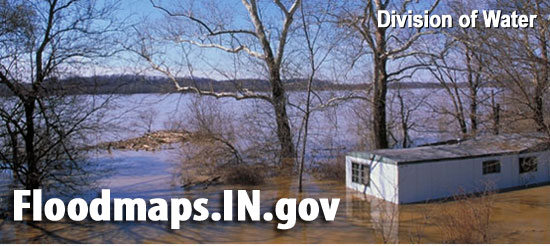Indiana Floodplain Mapping Quick Links
Indiana Floodplain Mapping
- Indiana Floodplain Mapping Story Maps
The Division of Water, along with our partners, have put together a series of ESRI Story maps that provide details on the derivation and use of Floodplain Mapping in Indiana. - The Indiana Floodplain Information Portal
Launch INFIP, an interactive floodplain mapping tool, which includes address searching and eFARA, the Division of Water’s on-line floodplain analysis submittal tools. INFIP also now includes the “Indiana Best Available Floodplain Layer”, showing up to date floodplain mapping information. - Indiana “Best Available” Floodplain Mapping
Download GIS data for the Indiana Best Available Floodplain Layer by county. - Interim Digital FIRMs
Digital versions of historic Flood Insurance Rate Maps from 2004. Use for historic and research purposes only.
Floodplain Management Links
- Indiana Floodplain Mapping
An ESRI Story Map depicting various sources for Floodplain Mapping for Indiana. - FEMA Map Service Center
View and download official FEMA floodplain mapping products, including Flood Insurance Rate Maps, Flood Insurance Studies, Letters of Map Change (LOMA, LOMR-F, LOMR) FIRM database information, and preliminary and historic mapping products. - The General Guidelines for the Hydrologic-Hydraulic Assessment of Floodplains in Indiana
Technical guidance documents for developing floodplain modeling for submittal to the Division of Water. Also includes external links to other modeling information. - USGS Flood Inundation Mapper
The Flood Inundation Mapper shows estimates of flood inundation areas based on USGS stream gage information. Areas are shown based on gage height, allowing users to view the approximate limits of a flood based on a reported gage reading. - Floodplain Management & Homeowner Information
More information regarding floodplain management with respect to both insurance and construction.
Hydrology Links
- The Indiana Peak Indiana Peak Discharge Determination System
Launch IPDDS, the Division of Water’s hydrologic computation system. Includes directions on how to submit information to the Division for approval. - USGS Streamstats
StreamStats for Indiana incorporates regression equations for estimating peak-flow frequency statistics at the 10-, 25-, 50-, 100-, 200-, and 500-year recurrence intervals (equivalent to the 10-, 4-, 2-, 1-, 0.5-, and 0.2-percent annual exceedance probabilities, respectively) for unregulated streams throughout Indiana, and equations for estimating bankfull-channel dimensions of width, mean depth, and cross-sectional area for non-urban wadeable streams in the three largest physiographic regions of Indiana. - Coordinated Discharges of Selected Streams in Indiana
By a Memorandum of Understanding of May 6, 1976, the U.S. Soil Conservation Service (now known as the Natural Resources Conservation Service), the U. S. Geological Survey (USGS), the U. S. Army Corps of Engineers (Louisville, Detroit and Chicago Districts) and the Indiana Department of Natural Resources (IDNR) mutually agreed to coordinated discharge-frequency values for use in water resources investigations and planning activities in the State of Indiana. - NOAA Atlas 14 Point Precipitation Frequency Estimates
Estimates of rainfall depths and distributions for various return periods throughout the state. - Estimation of Peak Discharges of Indiana Streams By Using log Pearson (III) Distribution:
Predictive equations developed for estimating peak flood for specified frequencies for streams in Indiana. - Drainage Areas of Indiana Streams
Drainage areas for all Indiana streams having a drainage area of at least five square miles are determined. Drainage areas at many other points, including entry and exit points for larger streams crossing the Indiana border, were also determined. - Probable Maximum Precipitation Estimates
Charts of Probable Maximum Precipitation for Indiana derived from National Weather Service publications. - Purdue Long-Term Hydrologic Impact Analysis
Purdue Long-Term Hydrologic Impact Analysis (LTHIA-IN) is a website that can be used to delineate watersheds and determine peak discharges using NRCS TR-55 methods.
Hydraulics Links
- The Indiana Hydrology and Hydraulics Model Library
View and download previous hydrologic and hydraulic models developed for Flood Insurance Studies, Construction in a Floodway applications, Floodplain Analysis / Regulatory Assessment (FARA), and others. - The Indiana DNR HEC-RAS Geometric Data Tool
This tool uses the State of Indiana’s LiDAR dataset, along with the National Hydrography Dataset, to create a Geometric Input file for HEC-RAS, the Corps of Engineers hydraulic modeling program. - HEC-RAS at the Hydrologic Engineering Center
Website for obtaining the HEC-RAS program, including example data. - HEC-2 Troubleshooting Guide
A guide by the Division of Water on how to handle HEC-2 datasets in HEC-RAS. - Notes on Critical Depth Messages
Guidance on reviewing and eliminating critical depth messages in HEC-RAS modeling.
Other Floodplain Data
- Fluvial Erosion Hazards in Indiana
The Fluvial Erosion Hazards portal features mapping of approximate areas of stream migration for communities to better manage river corridors. The setbacks vary based on the stream’s recent migration history (mobile or non-mobile). - Non Levee Embankments in Indiana
The Non-Levee Embankment project is a joint effort between The Indiana Silver Jackets, The Polis Center, IMAGIS/Indy GIS, INDNR and SIU Geography. The purpose of the project is to identify non-levee embankments (NLE) utilizing LiDAR and geoprocessing techniques. NLE are elevated linear features adjacent to waterways and within the floodplain. - Indiana DNR Basin Teams and ESC contact information
- Contact information for the ESC section managers.
- Frequently Asked Questions
Answers regarding floodplain maps and flood insurance.

